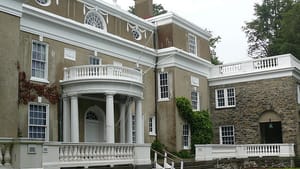Stay in the Loop
BSR publishes on a weekly schedule, with an email newsletter every Wednesday and Thursday morning. There’s no paywall, and subscribing is always free.
At home with FDR
FDR Presidential Library and Museum

From my early childhood in Ohio in the late 1940s, I remember my mother’s fear of polio for her family. Lakes and community swimming pools were especially frightening as presumed breeding grounds for the virus, mostly in the heat of summer. Relief came in 1953 when American children, including my brother Bruce and I, could be immunized with the Salk vaccine.
Franklin Delano Roosevelt, though born into privilege, was less fortunate: In 1921, at the age of 39, he contracted what is believed to have been polio, apparently either from falling from a boat into the Bay of Fundy one day or swimming in a lake the next, while summering in Canada. Not only did he never walk again, but he also didn’t move from the waist down.
On a chilly, sunny, spring day, I visited the buildings and grounds of Springwood, which is FDR’s birthplace, childhood home, marital estate, and burial plot. There I learned details of FDR’s illness as well as ways in which he met his condition. All told, the qualities that FDR cultivated — fortitude, equanimity, compassion, and transcendence — to live a prodigiously fruitful life in spite of extreme debilitation were the qualities that enabled him to lead the nation out of the morass of the Great Depression and through the horrors of World War II. In other words, FDR’s suffering — or rather the noncombative manner in which he responded to his suffering — was America’s blessing.
Disguising his disability
I began my tour through the portico of the Dutch colonial Franklin D. Roosevelt Presidential Library and Museum. Created by FDR with private funding and opened in 1941, it is the first of presidential libraries; moreover, it’s the only one to have been founded, as well as used, by a sitting president. Exploring the library, one gleans the extent to which FDR’s physical incapacity was kept hidden from the public.  For example, there is the office that FDR maintained for conducting business of state. His walnut desk and chair were situated on a diagonal so the president could be seated with his back to the corner, lower body concealed, when receiving guests and dignitaries. A wooden wheelchair is also on display, though a wheelchair would not have been intentionally exposed, with or without FDR in it, to anyone beyond the president’s inner circle.
For example, there is the office that FDR maintained for conducting business of state. His walnut desk and chair were situated on a diagonal so the president could be seated with his back to the corner, lower body concealed, when receiving guests and dignitaries. A wooden wheelchair is also on display, though a wheelchair would not have been intentionally exposed, with or without FDR in it, to anyone beyond the president’s inner circle.
The Museum portion of the building holds a radical example of rendering FDR as if able-bodied: a 1936 Ford Phaeton he drove un-chauffeured. Reconfigured without foot pedals, the automobile was maneuvered entirely by hand. And because FDR was a smoker, the dashboard boasts a device for dispensing lit cigarettes, one at a time. The consequent picture, with FDR at the wheel, would have been of a man with unimpeded body driving and smoking.
The Museum offers numerous full-length photos of FDR. When standing (by means of hefty, heavy metal leg braces concealed under his trousers), he is behind a podium or near some support. When seated, his legs are often crossed, giving the look of leg motility. But his legs were crossed, and his shoes scuffed, for him.
Eschewing an elevator
I toured the mansion with a group. Once everyone had viewed the downstairs rooms, the guide told us that while FDR kept an upstairs bedroom lifelong, he had no elevator installed. Instead, he hoisted himself to the second floor — using weights and pulleys (intact and viewable at the house), and by virtue of arm-muscle and courage, he would, hand-over-hand, get himself to the floor above.
 The guide attributed FDR’s rejection of an elevator to his fear of being trapped inside in the event of fire. My own experience suggests a deeper explanation. All my life, I’ve taken stairs rather than an elevator, whenever reasonable, and I’ve walked rather than taken a bus or subway. I would contend that FDR’s renunciation of an elevator (and not hiring porters) had more to do with confidence than fear.
The guide attributed FDR’s rejection of an elevator to his fear of being trapped inside in the event of fire. My own experience suggests a deeper explanation. All my life, I’ve taken stairs rather than an elevator, whenever reasonable, and I’ve walked rather than taken a bus or subway. I would contend that FDR’s renunciation of an elevator (and not hiring porters) had more to do with confidence than fear.
The guide explained that FDR was not ashamed of his paraplegia. Instead, given the times in which he lived, he chose not to present himself as having physical challenges, since conventional belief at the time was that an impaired body signified an impaired mind. Also, he must have determined, through the precarious years of 1933 to 1945, the country would best be served by a robust figure at the helm.
Lasting legacy
The 32nd President of the United States would have liked to have his life end at Springwood, where he was born. In 1944, sick and depleted, weary from the work of state, he declared: “All that is within me cries out to go back to my home on the Hudson River.” He did not manage to die at home, nor at the White House in Washington — he died in his own Little White House at Warm Springs, Georgia, a place of healing. There, years before, he’d established an Institute for Rehabilitation, where persons suffering paralysis could immerse in the waters, benefitting from hydrotherapy.
The death of FDR brought to light his polio and his forbearance, which redoubled research leading to the cure. My mother was grateful when her children could vacation at Lake Erie and splash carefree in the world’s largest recirculating pool at Cincinnati’s own Coney Island. With the legacy of FDR, once-threatening waters in the heat of summer were turned to friends.
Above right: FDR’s private study at the Library. (Photo courtesy FDR Presidential Library and Museum)
Above left: FDR’s 1936 Ford Phaeton. (Photo by Wally Gobetz via Creative Commons/Flickr)
What, When, Where
The Home of Franklin D. Roosevelt National Historic Site. 4097 Albany Post Rd., Hyde Park, NY. 1-800-FDR-VISIT or http://www.nps.gov/hofr/index.htm.
Sign up for our newsletter
All of the week's new articles, all in one place. Sign up for the free weekly BSR newsletters, and don't miss a conversation.

 Joanna Rotté
Joanna Rotté